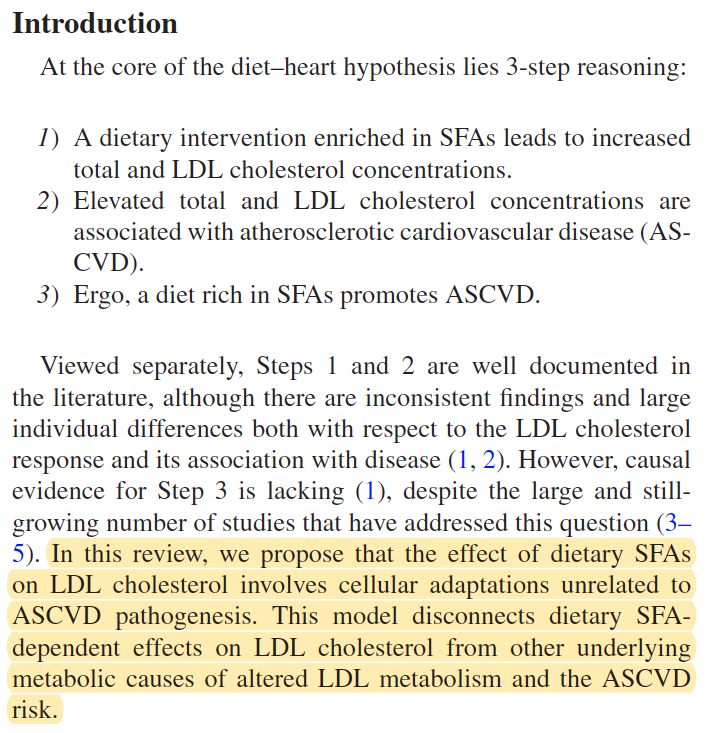1/ #ReadingThread
This paper by @zinocker, @kariannesve, @simondankel is proving an interesting read. Before I get too much further, I'm going to turn it into a "reading thread" and post some of these quotes as I go...
(Big hat tip to @bigfatsurprise) https://academic.oup.com/ajcn/advance-article-abstract/doi/10.1093/ajcn/nqaa322/6104795
This paper by @zinocker, @kariannesve, @simondankel is proving an interesting read. Before I get too much further, I'm going to turn it into a "reading thread" and post some of these quotes as I go...
(Big hat tip to @bigfatsurprise) https://academic.oup.com/ajcn/advance-article-abstract/doi/10.1093/ajcn/nqaa322/6104795
2/ "In this paper we propose a novel model, the homeoviscous adaptation to dietary lipids (HADL) model, which explains changes in lipoprotein cholesterol as adaptive homeostatic adjustments that serve to maintain cell membrane fluidity and hence optimal cell function."
3/ Later in the abstract: "Hence, circulating levels of LDL cholesterol may change for nonpathological reasons. Accordingly, an SFA-induced raise in LDL cholesterol in healthy individuals could represent a normal rather than a pathologic response."
4/ I really like how they open with this. It summarizes the (1) and (2) as acknowledged to put focus on (3) specifically.
5/ "Large interindividual differences in responses have been
demonstrated from dietary interventions investigating the effects of changing SFA/PUFA ratios on total and LDL cholesterol."
I agree -- but I'd love if I had the funding to do an RCT on lean Ns to LMHRs specifically.
demonstrated from dietary interventions investigating the effects of changing SFA/PUFA ratios on total and LDL cholesterol."
I agree -- but I'd love if I had the funding to do an RCT on lean Ns to LMHRs specifically.
6/ "To our knowledge, no studies to date have presented a model that makes it possible to explain, at the individual level, the response in lipoprotein particles from changes in saturation levels of dietary fatty acids.."
( #NoteToSelf- get that #LipidEnergyModel paper out soon!)
( #NoteToSelf- get that #LipidEnergyModel paper out soon!)
7/ "Our hypothesis is based on the idea that cells in select tissues of the human body adapt to the changing availability of dietary fatty acids by regulating the amount of cholesterol molecules in cell membranes, largely to ensure optimal cell function."
8/"Moreover, the observed decrease in cholesterol in lipoproteins after an increase in PUFA intake does not seem to be caused by reduced [chol] synthesis. Ramprasath... found no difference in [chol] absorption or synthesis with increased dietary intake of PUFAs relative to SFAs."
9/ "On the contrary, several studies have found increased endogenous cholesterol synthesis when subjects were fed diets higher in PUFAs than their baseline diets, or compared to diets high in SFAs, without increasing cholesterol concentrations in lipoproteins (36, 40, 41)."
10/ "We argue that the changes in cholesterol in lipoproteins
observed with a change of fatty acids in the diet arise from
a redistribution of cholesterol molecules already present in
different tissues."...
observed with a change of fatty acids in the diet arise from
a redistribution of cholesterol molecules already present in
different tissues."...
11/ "The purpose of this redistribution is to maintain
optimal cell function by fine-tuning membrane fluidity. This
phenomenon is called homeoviscous adaptation: a well described mechanism by which microorganisms and animals adapt to changing environmental conditions."
optimal cell function by fine-tuning membrane fluidity. This
phenomenon is called homeoviscous adaptation: a well described mechanism by which microorganisms and animals adapt to changing environmental conditions."
12/ So this is actually seems like a very testable hypothesis in the way it's being described thus far in the paper.
Kinda makes me I biobanked some tissue biopsies when I started my #keto diet.
Kinda makes me I biobanked some tissue biopsies when I started my #keto diet.

13/ "The dietary intake levels of PUFAs will
change the composition of fatty acids in membrane phospholipids in mammals, as shown in rodents, pigs, and humans, thereby requiring adjustments in cholesterol levels to ensure normal membrane function."
change the composition of fatty acids in membrane phospholipids in mammals, as shown in rodents, pigs, and humans, thereby requiring adjustments in cholesterol levels to ensure normal membrane function."
14/ "A need for increased cholesterol
incorporation in cell membranes may therefore largely explain
the lipoprotein cholesterol−lowering effect from dietary
PUFAs."
Interesting. Most PUFA hypotheses of LDL lowering are generally within hepatic or circulatory context...
incorporation in cell membranes may therefore largely explain
the lipoprotein cholesterol−lowering effect from dietary
PUFAs."
Interesting. Most PUFA hypotheses of LDL lowering are generally within hepatic or circulatory context...
15/ ... I myself am interested in how much there may be further lowering due to scavenger receptor activity on a higher proportion of oxLDL.
But in this case, they are postulating greater uptake by design to meet fluidity demands posed by the higher PUFA membrane incorporation.
But in this case, they are postulating greater uptake by design to meet fluidity demands posed by the higher PUFA membrane incorporation.

 Read on Twitter
Read on Twitter


